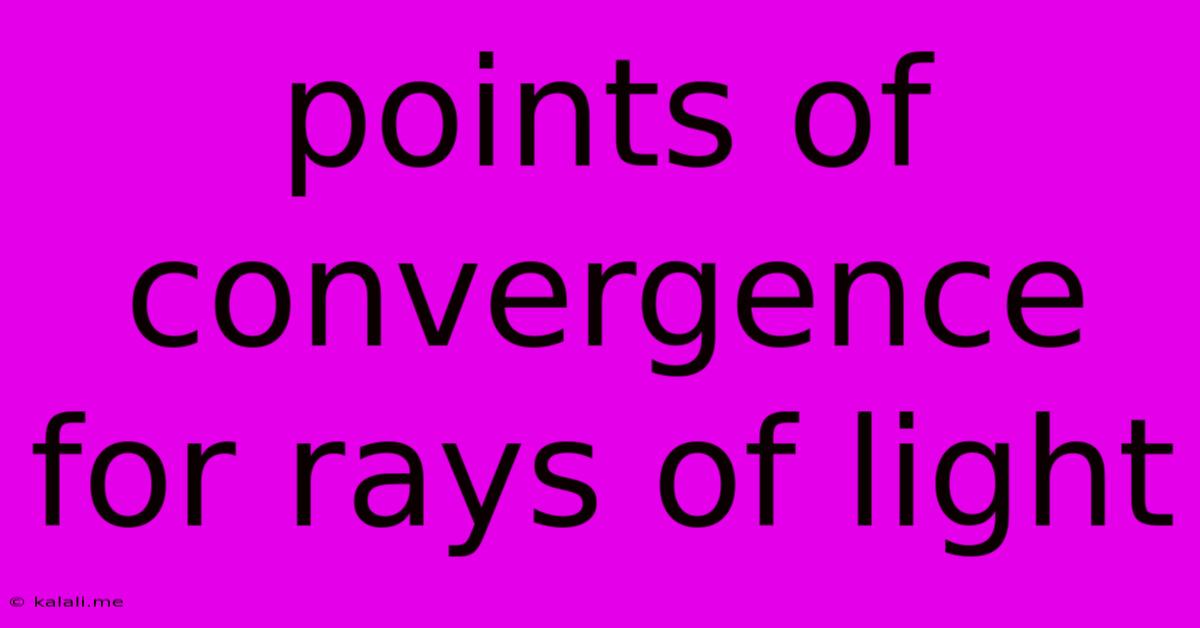Points Of Convergence For Rays Of Light
Kalali
May 19, 2025 · 3 min read

Table of Contents
Points of Convergence for Rays of Light: A Deep Dive into Focal Points and Image Formation
This article explores the fascinating world of light convergence, explaining the different points where light rays meet and their significance in optics and image formation. Understanding these convergence points is crucial for comprehending how lenses, mirrors, and other optical instruments work. We'll delve into the concepts of focal points, real and virtual images, and the factors influencing these convergence points.
What is a Point of Convergence?
A point of convergence, simply put, is the location where multiple rays of light intersect after reflection or refraction. This intersection point is crucial in determining the formation of images, whether real or virtual. The nature of this point – its position and whether the rays actually converge there – depends on the optical system involved and the properties of the light rays themselves.
Focal Points: The Heart of Convergence
The most common and significant point of convergence is the focal point (or focus). This point is defined differently for lenses and mirrors:
-
For Converging Lenses (Convex Lenses): The focal point is the point where parallel rays of light, after passing through the lens, converge. The distance between the lens and the focal point is the focal length (f).
-
For Converging Mirrors (Concave Mirrors): The focal point is the point where parallel rays of light, after reflecting off the mirror, converge. Again, the distance from the mirror to the focal point is the focal length (f).
Real vs. Virtual Images: The Role of Convergence
The type of image formed – real or virtual – depends directly on where the rays converge:
-
Real Images: Formed when light rays actually converge at a point. Real images can be projected onto a screen. They are inverted and can be formed by converging lenses or mirrors when the object is beyond the focal point. The point of convergence for a real image is a physical point where the light rays intersect.
-
Virtual Images: Formed when light rays appear to converge at a point, but they don't actually intersect there. Virtual images cannot be projected onto a screen. They are upright and are often formed by diverging lenses or when an object is placed closer to the mirror or lens than its focal point. The point of convergence for a virtual image is a perceived point, an apparent intersection of the extrapolated light rays.
Factors Affecting Points of Convergence:
Several factors influence the exact location of the convergence point:
-
Focal Length: A shorter focal length leads to a closer convergence point, and vice versa.
-
Object Distance: The distance between the object and the lens/mirror significantly impacts the image location and therefore, the convergence point.
-
Lens/Mirror Shape: The curvature of the lens or mirror directly influences the light ray bending and thus, the convergence point. A more strongly curved lens/mirror will have a shorter focal length.
-
Refractive Index (for lenses): The refractive index of the lens material determines how much the light bends as it passes through the lens, affecting the convergence point.
Applications of Understanding Convergence Points:
The principles of light ray convergence are fundamental to many optical technologies, including:
-
Cameras: Lenses in cameras are designed to focus light onto a sensor, creating a real image.
-
Telescopes: Telescopes utilize lenses and mirrors to collect and converge light from distant objects, creating magnified images.
-
Microscopes: Microscopes employ lenses to magnify tiny objects, relying on precise light convergence to form clear images.
-
Projectors: Projectors use lenses to create a real image from a source, which is then projected onto a screen.
Understanding the points of convergence for rays of light is essential for anyone interested in optics, photography, or any field involving the manipulation and control of light. By grasping these concepts, we can better appreciate the intricate workings of optical instruments and the fascinating science behind image formation.
Latest Posts
Latest Posts
-
How Do You Stop Paint From Peeling
May 19, 2025
-
Why Is It Called Garden Leave
May 19, 2025
-
Average Treatment Effect On The Treated
May 19, 2025
-
How Long Are Guppies Pregnant For
May 19, 2025
-
It Was A Pleasure Meeting You
May 19, 2025
Related Post
Thank you for visiting our website which covers about Points Of Convergence For Rays Of Light . We hope the information provided has been useful to you. Feel free to contact us if you have any questions or need further assistance. See you next time and don't miss to bookmark.